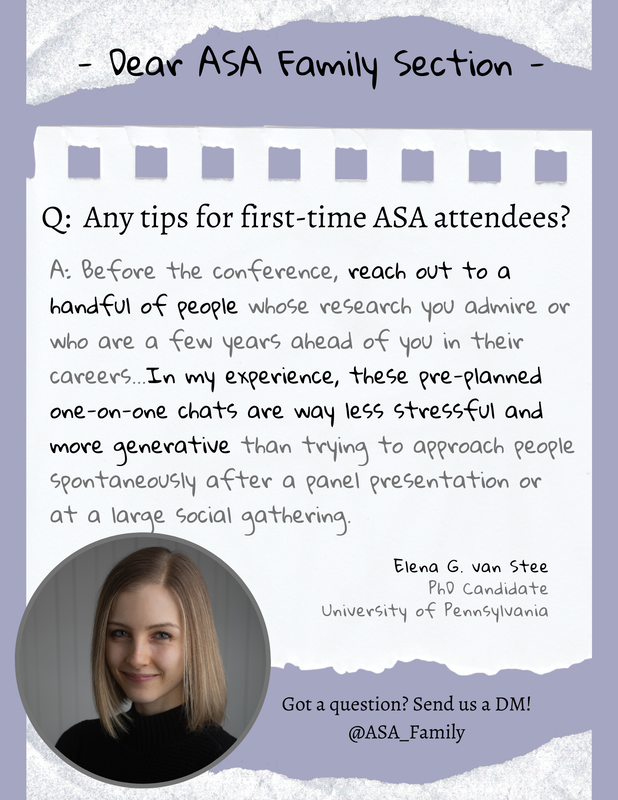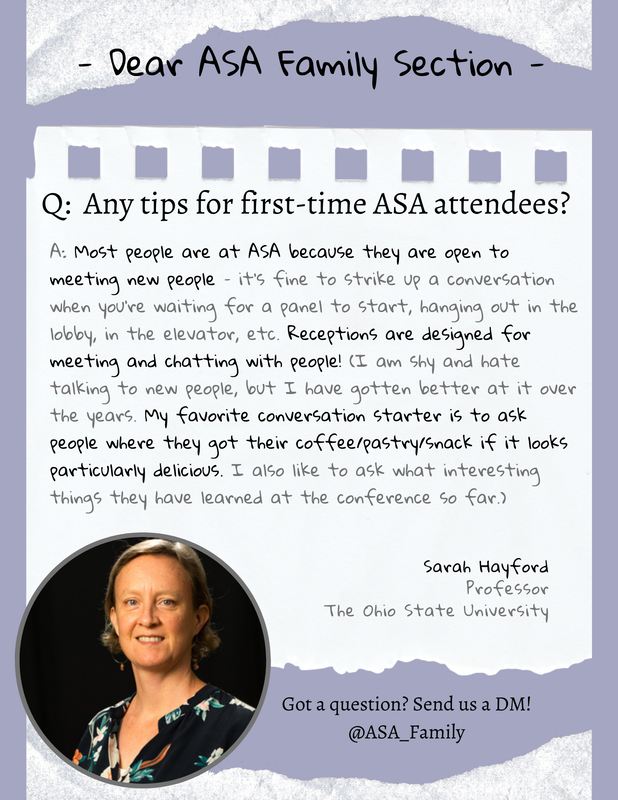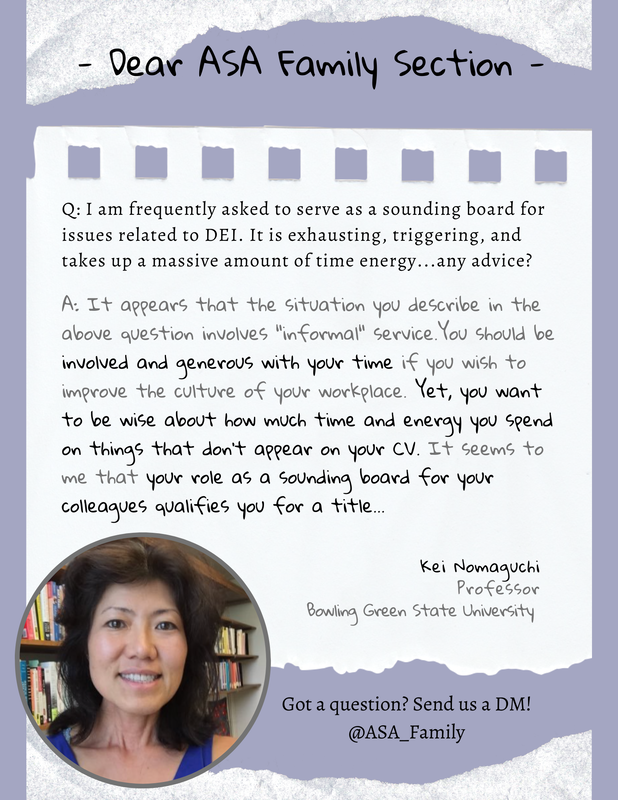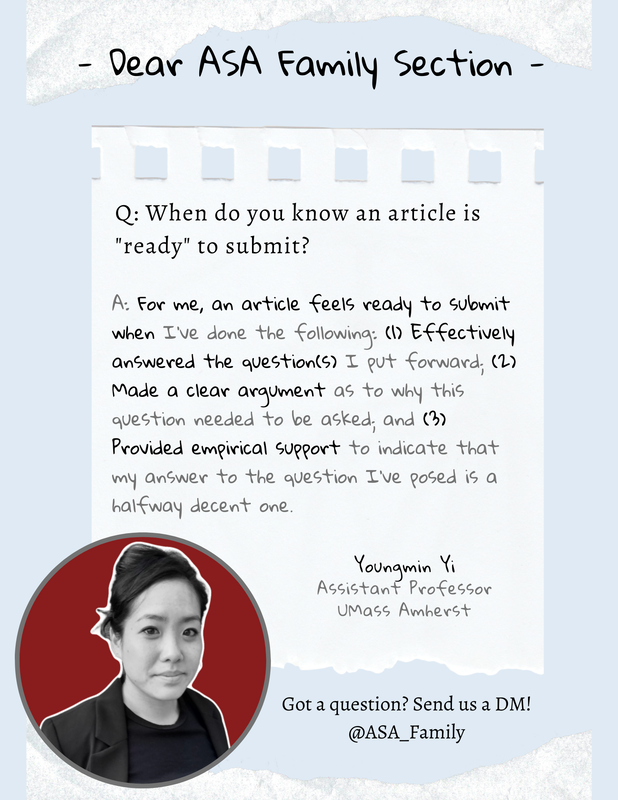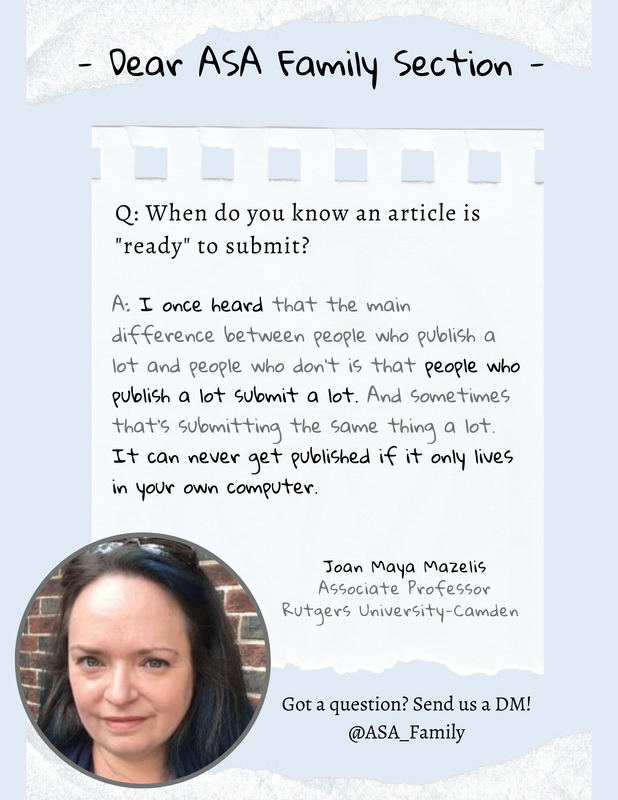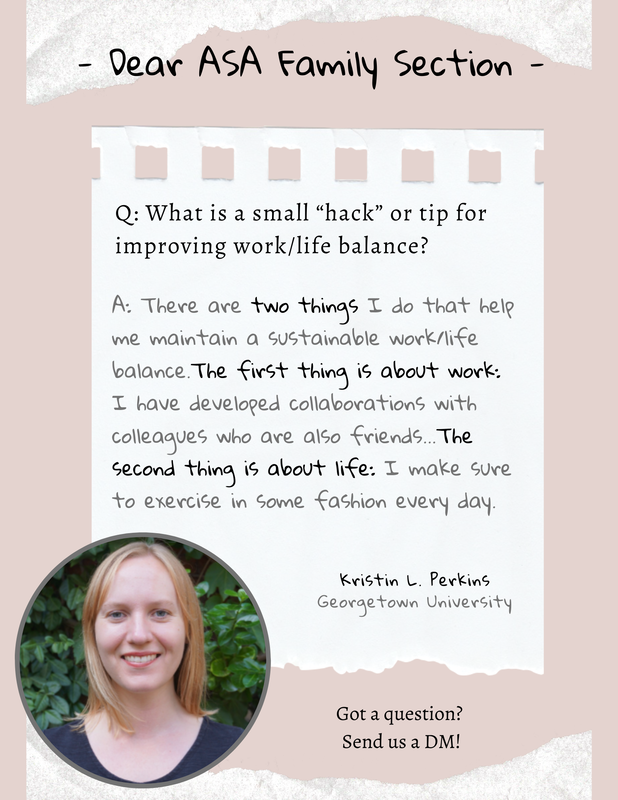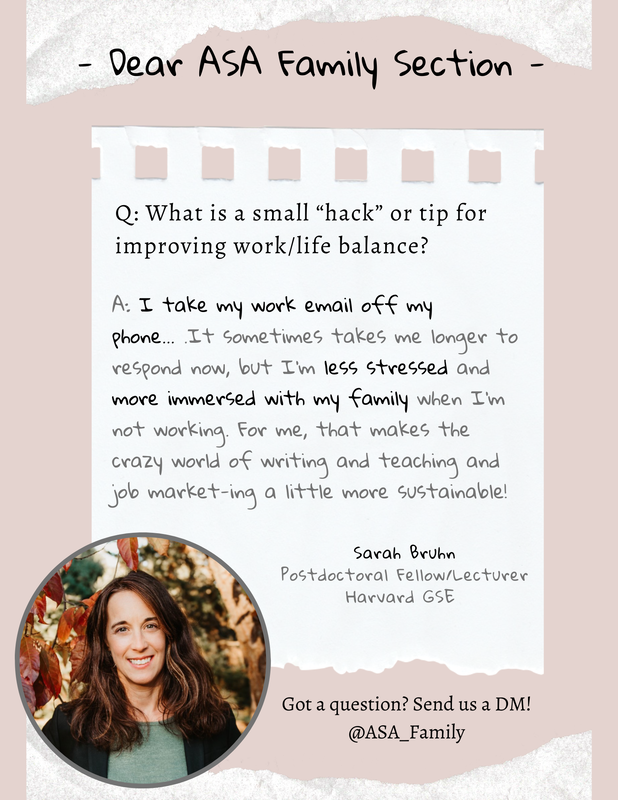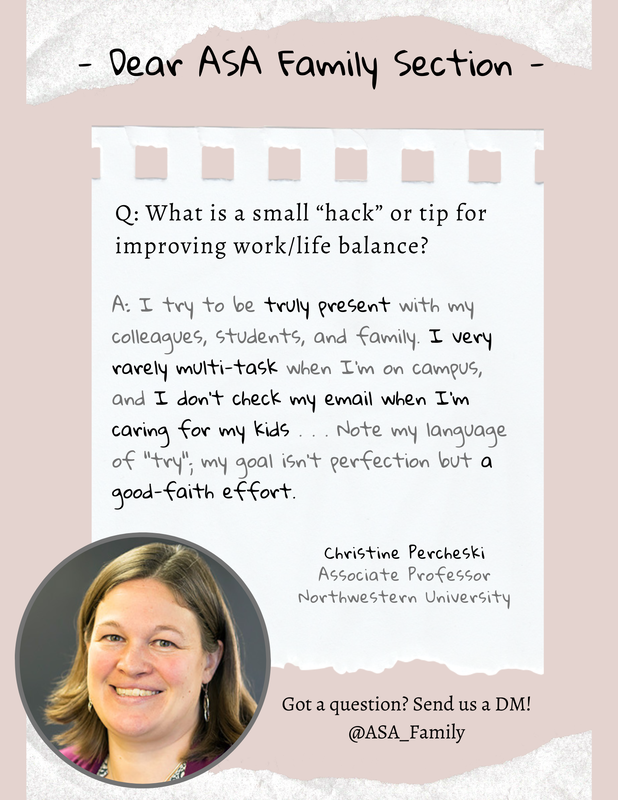|
This post is part of a new series from the Mentoring & Inclusion Committee called Dear ASA Family Section. It's a Dear Abby style Q+A where more advanced family sociologists answer questions from members. Q: Navigating the ASA Conference: How should I approach networking during the conference? Do you have any tips for first-time attendees? A: Here’s one tip: Before the conference, reach out to a handful of people whose research you admire or who are a few years ahead of you in their careers and see if they'd be interested in meeting for coffee or connecting at a section reception. In my experience, these pre-planned one-on-one chats are way less stressful and more generative than trying to approach people spontaneously after a panel presentation or at a large social gathering. With some good luck, you’ll also make serendipitous connections at the conference. But you don’t want to solely depend on luck! Elena G. van Stee PhD Candidate University of Pennsylvania A: Navigating panels:
1. Don’t try to go to everything! You can only fit so many panels into a day. 2. Some people try to go to multiple panels in the same time slot to see specific papers – I’ve never been able to pull this off, people always get off schedule, so I recommend picking one panel and sticking to it. 3. I try to go to a mix of topics I know well and topics that are out of my expertise – a panel at ASA is a good low-commitment way to find out what is going on in other fields or learn about new methods/datasets that you aren’t familiar with. Meeting people at a conference (I really hate the word “networking”): 1. You might have a specific person you want to ask a specific question of at ASA – for these kinds of questions, it’s good to plan in advance. Send an email ahead of the conference to set up a time to talk. (The more senior/well known a person is, the busier they are likely to be, unfortunately, but it never hurts to ask, and people may be willing to email or meet outside of the conference even if they’re not available at ASA.) 2. Or, you might want to meet people just to get to know what others are working on or to have people to exchange ideas with. To me, these are the most valuable kinds of interactions at a conference. For these conversations, I think people at a similar career stage are likely to be most receptive (and also most useful). This is especially true for graduate students – making friends with other students is fun, and other students will be your long-term colleagues in the field, so these are great connections to make. 3. Most people are at ASA because they are open to meeting new people – it’s fine to strike up a conversation when you’re waiting for a panel to start, hanging out in the lobby, in the elevator, etc. Receptions are designed for meeting and chatting with people! (I am shy and hate talking to new people, but I have gotten better at it over the years. My favorite conversation starter is to ask people where they got their coffee/pastry/snack if it looks particularly delicious. I also like to ask what interesting things they have learned at the conference so far.) Sarah Hayford Professor, Director of the Institute for Population Research The Ohio State University
0 Comments
This post is part of a new series from the Mentoring & Inclusion Committee called Dear ASA Family Section. It's a Dear Abby style Q+A where more advanced family sociologists answer questions from members.
Q: I am frequently asked by self-identifying white "allies" in my workplace to serve as a sounding board or "friend" with whom to discuss both personal and larger issues related to diversity, equity, and inclusion. It is exhausting, triggering, and takes up a massive amount of time and mental and emotional energy. This has always been an issue but has gotten so much worse over recent years. I also happen to be a junior faculty member, a woman, and not white. Does anyone have any advice for (1) avoiding/setting boundaries so that this doesn't happen as frequently, and (2) extricating oneself from these dynamics and relationships? Kei Nomaguchi Professor of Sociology Bowling Green State University A: In recent years, many organizations—academic, business, and nonprofit—have included Diversity, Equality, and Inclusion (DEI) in their strategic planning. I think this is fantastic because it compels us to be thoughtful when selecting new hires, members of task forces and committees, and speakers for important events. Without this structure, people are prone to select others from within their social networks. Given this trend, I, a person of color, cannot help but think, "Am I a DEI hire?" whenever I receive a request to serve on or chair a committee. Yet, I came to the conclusion that it does not matter how I was chosen. I would be pleased to contribute to my organization or the professional community, and I will make every effort to broaden my horizons and collaborate with others while doing so. Do you receive too many requests to serve on committees? Then you should be selective. Consider whether accepting the position will strengthen your CV or professional network. After repeating similar committee tasks at similar levels, it's time for you to say no to these responsibilities and yes to leadership roles in these tasks. It appears that the situation you describe in the above question involves "informal" service. I would give you the same advice for any casual service. You should be involved and generous with your time if you wish to improve the culture of your workplace (or maintain it if it is already collegial). Yet, you want to be wise about how much time and energy you spend on things that don't appear on your CV. It seems to me that your role as a sounding board for your colleagues qualifies you for a title. You could suggest to your colleagues or your department chair that setting up an ad hoc committee with a few additional people from minority groups who can act as a "sounding board" for various DEI-related concerns would benefit the department's members. You could argue that your viewpoint and experience may not be applicable in all circumstances; it would be better if the department formed a committee with others who could bring in various perspectives and experiences. This post is part of a new series from the Mentoring & Inclusion Committee called Dear ASA Family Section. It's a Dear Abby style Q+A where more advanced family sociologists answer questions from members. Q: When do you know an article is "ready" to submit? I know it will never be perfect, so I’m wondering how you decide when to submit. Youngmin Yi A: This is a tough (and good) question that I still grapple with – and I imagine I will for the rest of my publishing career! I’ve seen numerous approaches to knowing when a paper is “ripe” for submission for peer review; mine is just one perspective. I also want to caveat my reply with the note that my work to date has exclusively drawn on quantitative methods, which shapes what a manuscript “should” look like, as well as how the writing process unfolds. With all that said, for me, I think an article feels ready to submit when I personally feel that I’ve done the following: (1) Effectively answered the question(s) I put forward (and made that answer clear); (2) Made a clear argument as to why this question needed to be asked (the front end/motivation/argument is clear, supported, and connects to and acknowledges its building blocks, i.e., key concepts and findings that were previously established or introduced); and (3) Provided empirical support to indicate that my answer to the question I’ve posed is a halfway decent one, by following empirical breadcrumbs to alternative explanations or challenges to my answer/approach. Now, the review process is ideally going to help me do all of these things even more effectively, but I don’t generally think of the review process as a way to “workshop” a paper. I would also argue that we have to at least have convinced ourselves that we’ve done the above and believe ourselves that the paper has something important to get out there before we ask peer reviewers to consider the manuscript. Part of that self-convincing should involve workshopping and getting feedback from colleagues, friends, and advisors. I tend to struggle quite a bit with getting feedback on my work pre-submission, so my current rough requirement for myself has been at the very least (a) one workshop (conference, working group, etc.) and (b) one advisor/mentor/peer’s read-through/feedback on a very advanced draft prior to submission. I also want to acknowledge the realities of the job market and tenure and timing. These put constraints and deadlines on an intellectual process that is generally non-linear and rife with complications and unexpected challenges. These considerations vary by subfield and journal, and people are facing different professional and personal needs. However, I’d encourage people not to shy away from acknowledging and considering the practical aspects of timing (with a personal mentor!) alongside the points I’ve suggested above. Joan Maya Mazelis A: It’s great you know that there isn’t a time when it’s perfect – neither the timing nor the article will ever be perfect, as perfection doesn’t exist! Too often scholars (I think particularly junior scholars still learning to trust themselves and their analyses, but sometimes more senior scholars as well) postpone sending an article out much longer than they need to. I once heard that the main difference between people who publish a lot and people who don’t is that people who publish a lot submit a lot. And sometimes that’s submitting the same thing a lot. It can never get published if it only lives in your own computer. Remember, rejection is the most common outcome for submitted articles! But those rejections can and do often come with meaningful reviews full of helpful and constructive advice (even if there is sometimes less-constructive advice or harsh criticism as well). So sometimes having other scholars in your field review your piece can help you move it forward in the process. I also got better at sending things out for review sooner when I began to review for journals more; I read many manuscripts that seemed less polished than I had assumed my own manuscripts had to be before sending them out. It’s also good to send things out to overcome the anxiety some of us feel at letting others read our work: the more you do it, the easier it gets, and the more sending it out for initial review begins to feel like just one step in the process. When we sit on a piece for a long time and keep obsessing on revising minor details before sending, we tend to think of sending it out for review as a final step, when really, it’s somewhere in the middle: research, analysis, writing, revising, sending out for review, revising, sending out for review again, revising again, etc. If you know your article isn’t “done” in that, for example, you haven’t completed your analysis, finished writing your methods section, or written a compelling conclusion, then it’s obviously not ready. If you aren’t sure where to send it or haven’t formatted your citations the way the journal you’ve chosen requires, you’re not ready. But if you’ve chosen the journal and correctly formatted your citations, you’ve included all the pieces you intend, you’ve read it through for flow and grammar and errors, and – if you’re lucky – also had a friend, colleague, editor, or writing group pal read it through for you, you’re ready to send it out. When you do send it out, think about the next journal you might want to submit to if it gets rejected. If you’re already prepared with that information, it will be much easier to send the paper elsewhere if you need to. This post is part of a new series from the Mentoring & Inclusion Committee called Dear ASA Family Section. It's a Dear Abby style Q+A where more advanced family sociologists answer questions from members. Q: What is a small “hack” or tip for a healthier work/life balance that you have found do-able but impactful (even if only a little)? Kristin L. Perkins A: There are two things I do that help me maintain a sustainable work/life balance. The first thing is about work: I have developed collaborations with colleagues who are also friends. This means that I always look forward to talking to them when we meet to work on our projects, and I am motivated to make progress on our projects because I am accountable to them. It also means that I can be honest with them when I'm not sure about an analytic decision I've made, or what direction a paper should take, or when I'm unable to make progress or meet a deadline because other work or life responsibilities intervene. The second thing is about life: I make sure to exercise in some fashion every day. Some days this is a cycling class, but just as often it is a short yoga or Pilates class, or even a simple 10-minute stretch. The format matters less than the commitment to doing something—anything—every day. Usually this is a total break from work, but sometimes I do come up with an idea for my research or teaching while I'm walking to or from my office, or when I’m taking a break to exercise. Sarah Bruhn A: One small hack I've found really helpful is to take my work email off my phone. As a mother of 3, I used to feel that I needed the flexibility to keep up with email by having access to it all the time. It sometimes takes me longer to respond now, but I'm less stressed and more immersed with my family when I'm not working. For me, that makes the crazy world of writing and teaching and job marketing just a little more sustainable! Christine Percheski
A: One small but important thing I do is to try to be truly present with my colleagues, students, and family. I very rarely multi-task when I'm on campus (e.g., I don't reply to emails while attending meetings or research talks), and I don't check my email when I'm caring for my kids. I also try to focus on the task that I'm engaged in instead of worrying about the tasks and emails that aren't getting my attention. Note my language of "try"; my goal isn't perfection but a good-faith effort. |
|
